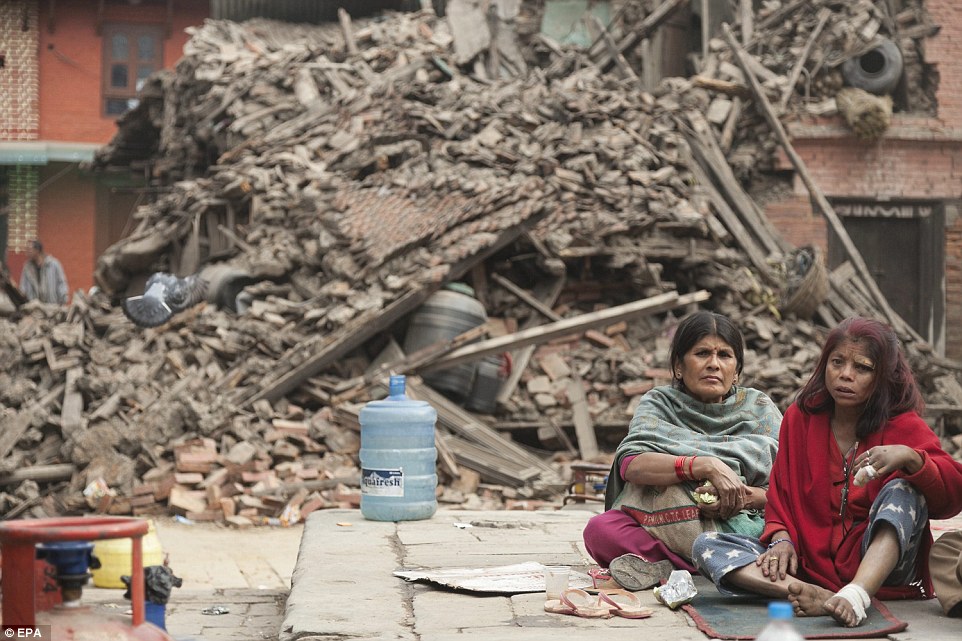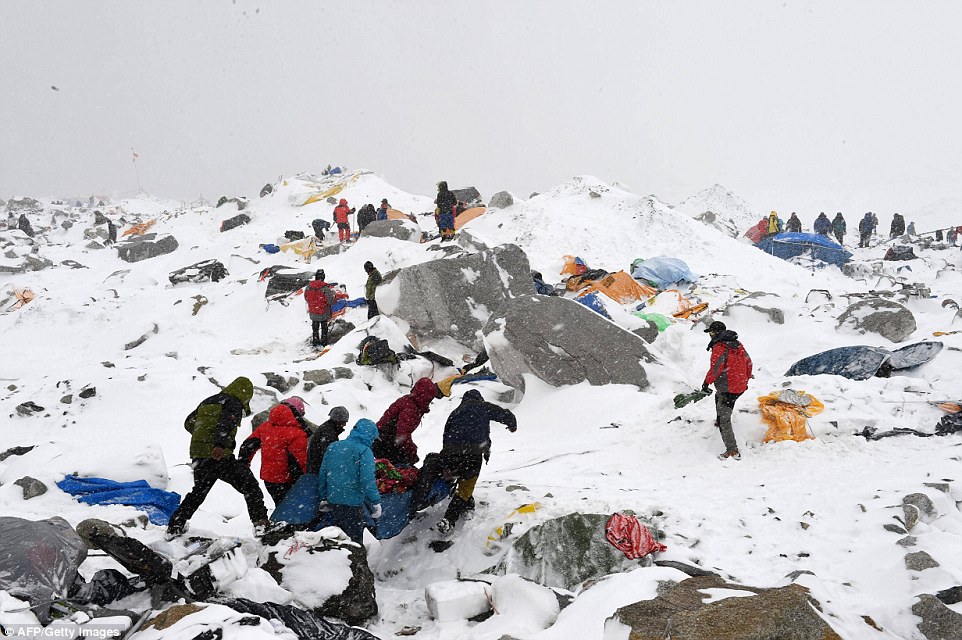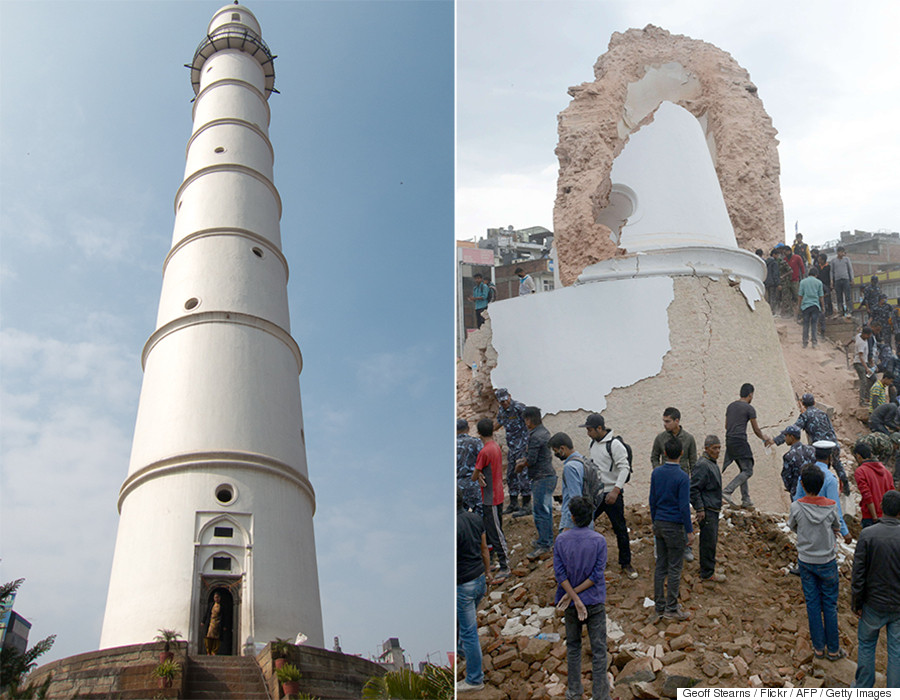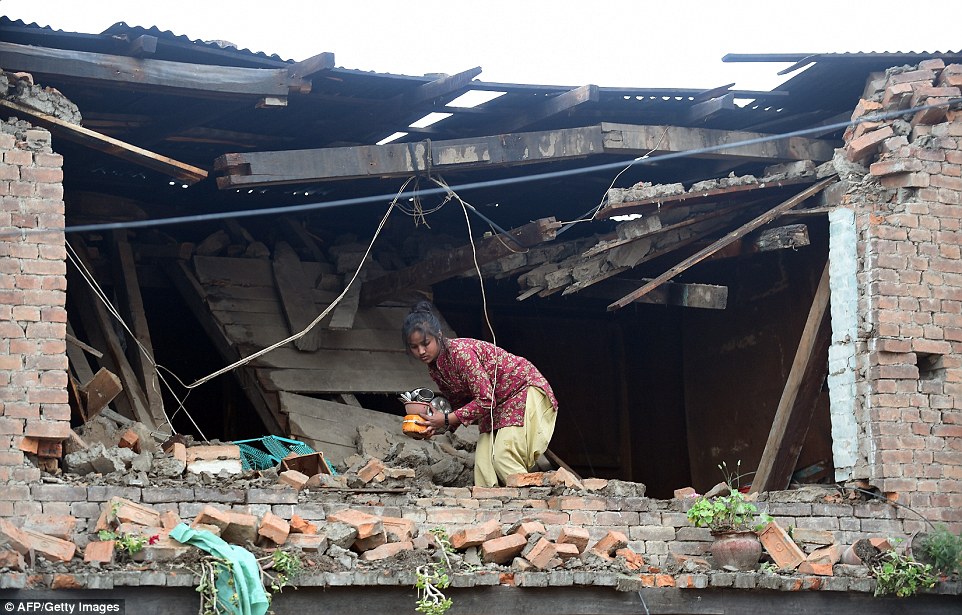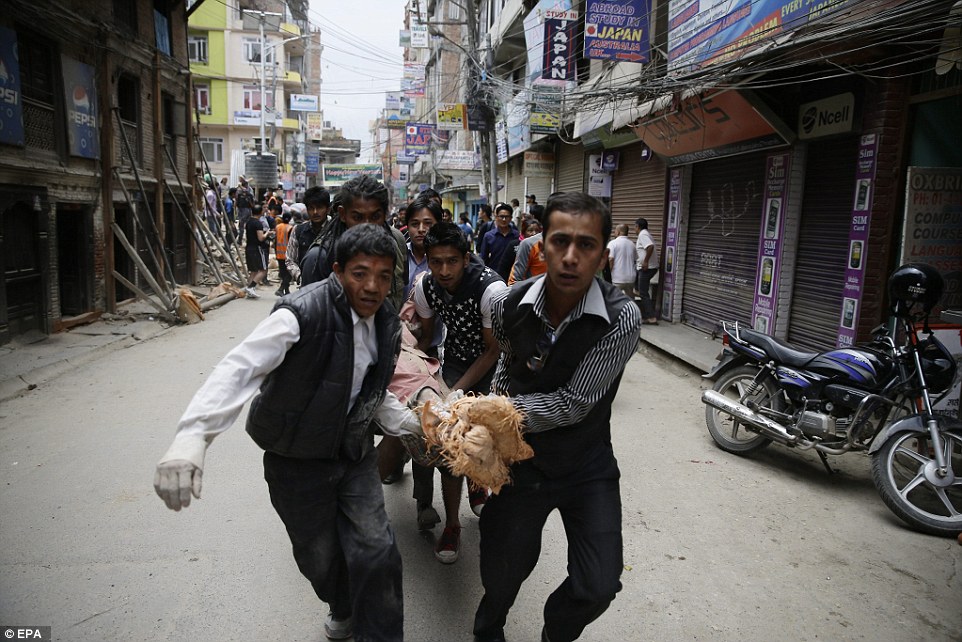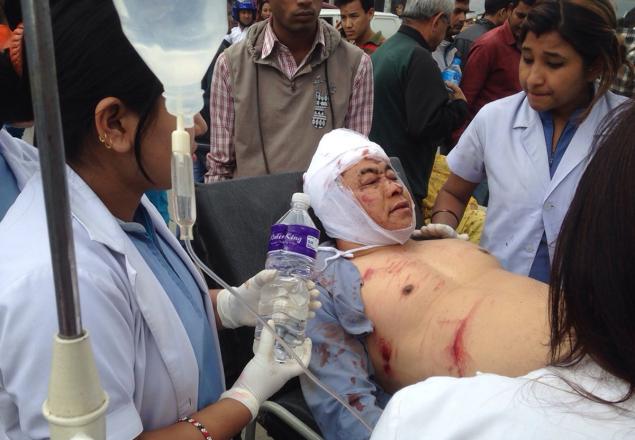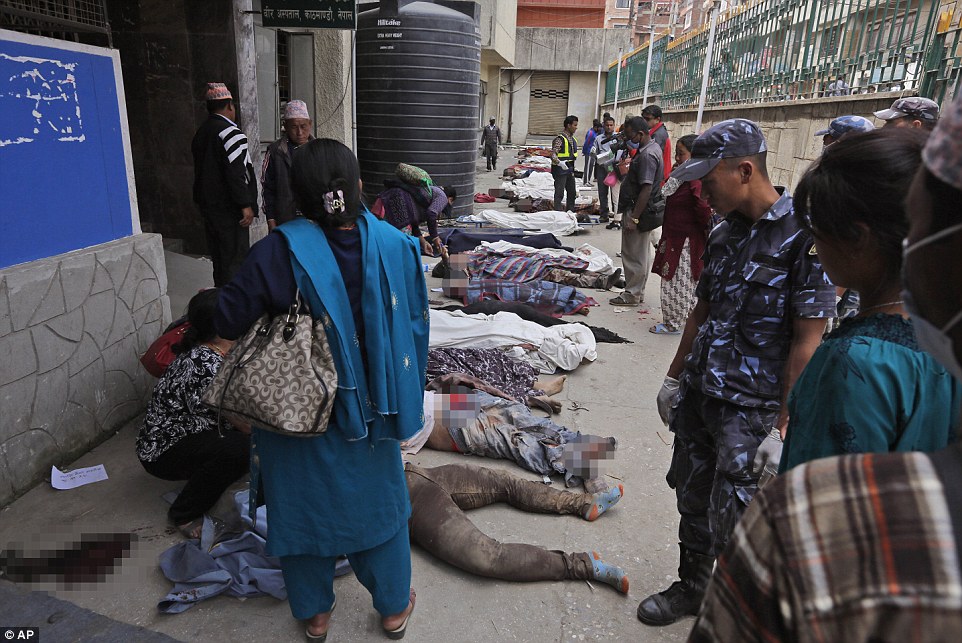Stories From Nepal: "I Thought I Had Died. How Can We Sleep At Night?"
Firsthand accounts of the Nepal earthquake reveal the degree of damage and looming problems on not only its country, but its people too.
On 25 April, a 7.8 magnitude earthquake hit Nepal and left survivors in devastating conditions
By 28 April, Nepalese authorities had raised the death toll to more than 4,400 people. The uncertainty over the degree of damage and what the future might hold spreads fear and anxiety across Nepal. For now, getting through the day and night is the immediate challenge as aftershock after aftershock continues to rattle this country and its unnerved people.
"When the earthquake struck, we huddled under a concrete beam -- and prayed," says journalist Sunir Pandey. With tremors repeating throughout the night, he did not sleep a wink.
According to Journalist Sunir Pandey, "When the earthquake struck, we huddled under a concrete beam -- and prayed. Outside, a brown dust cloud rose from the ruins of cottages that had dotted the next hill.
The journey towards my family home in Sifal was a map of quake destruction, with many houses torn apart. In Kathmandu Durbar Area, it was reduced to rubble. A blood donation camp was said to be buried by the same structure that sheltered it. Locals were searching for survivors, but progress was slow.
People huddle together outside a hospital in Kathmandu gathering mostly in the middle of crossroads, on traffic islands and around metal pulpits, which looked out of range of falling buildings.
We kept hearing rumors: 'More quakes forecast by experts for 5 p.m. and midnight.' As if to confirm, tremors shook us at six and more would follow at 10 p.m. and midnight, with smaller shocks throughout the night. I did not sleep a wink."
People carry a woman from the rubble of a destroyed building while locals and rescue teams continue to search for more survivors.
Image via Daily Mail"I thought I had died," says a jolted Ichcha Gauchan when her neighbouring houses started to sway during the earthquake. She echoed Pandey's fear, "How can we sleep at night?"
“I thought I had died,” she said. She is sleeping at the military parade ground, and although her house is intact, she does not plan to return home for several days. “How can we sleep at night?”
“I managed to dig out of what could easily have been my grave... I was suffocating, I could not breathe,” says Bhim Bahadur who suffered the avalanche that swept through Mount Everest. "I had lived but lost many of my friends"
A photograph of Everest basecamp after the avalanche struck yesterday shows climbers carrying the injured in sleeping bags.
Image via Daily MailOn Sunday, the first groups of survivors were flown off Everest by aid helicopters. Two sherpas who survived the avalanches have since spoken of the horror. Bhim Bahudar Khatri, a cook for the climbing team, said: "I was cooking for my team in the meal tent when the earthquake hit. We all rushed out to the open and the next moment a huge wall of snow just piled on me."
"I managed to dig out of what could easily have been my grave. I wiggled and used my hands as claws to dig as much as I could. I was suffocating, I could not breathe. But I knew I had to survive. I dug a few more feet until I was out of the snow and could breathe. I looked around and saw the tents all torn, crushed and many people injured. I had lived but lost many of my friends," he said.
Climbers and Sherpas were buried under rock and ice at the mountain's 18,000-foot-high base camp. "There are still many people who are still missing on the mountain. There were several tents buried by the snow, several blown away." says Pemba Sherpa, 43, one of the sherpas who survived.
Image via Daily Mail“Not only Nepal is crying but all Nepalis in the world are crying. We are dumbstruck. It is painful to see the people in my country suffer," says Bahadur Shretsa, one of the worried Nepalis working here in Malaysia
The Dharahara Tower, which to me is like the ‘KLCC of Nepal’, is gone." says Janak.
Image via Geoff Stearns /AFPFactory worker Janak BK, 31, returned from Nepal five days ago after attending his mother’s funeral at Okaldonga, near Mount Everest.
“My family is fine. But I am worried for my 72-year-old father who is alone,” said Janak, who has lived in Malaysia for 10 years. “My wife is in Kathmandu and constantly updates me on the situation,” he said, adding that he had yet to speak to his father. “The whole village is a mess. Even Kathmandu. The Dharahara Tower, which to me is like the ‘KLCC of Nepal’, is gone. Not only Nepal is crying but all Nepalis in the world are crying. We are dumbstruck. It is painful to see the people in my country suffer.”
"On that day, my family managed to call me to say everyone is fine. After that, I could not contact them. I was told that my village is gone and we do not have a house now," Purna Bahadu Shresta, a Nepali factory worker in Malaysia
Another factory worker, Purna Bahadur Shretsa, 23, said his district, Gorkha, was badly affected and he had not been able to contact his family due to network problems. “On that day, my family managed to call me to say everyone is fine. After that, I could not contact them. I was told that my village is gone and we do not have a house now. I am worried, but I can only leave it in God’s hands,” said Shretsa.
He said he would return to Nepal once the situation was under control and help rebuild his family’s house. “I want to go back and see my mother and three siblings. I want to be there to help them rebuild their lives. This is just devastating.”
It's been three days since the quake but the people of Nepal are still scared. “Everyone is saying it will come again. No one is going to sleep at home,” says security guard Samir Thapa.
Tents are seen from an airplane window in an open field next to Tribhuwan International Airport Read more: http://www.dailymail.co.uk/news/article-3056263/The-hunt-survivors-Nepalese-officials-warn-death-toll-devastating-quake-hit-10-000-scores-American-families-thousands-searching-unaccounted-for.html#ixzz3YZBBuylC Follow us: @MailOnline on Twitter | DailyMail on Facebook
Image via Daily MailThat, too, added to the uncertainty, the sense that sleeping in the street, in the rain, was the only hedge against the randomness of fate.
“Everyone is scared,” said Samir Thapa, a 30-year-old security guard who, like thousands of other residents, slept in the tent city.
“We don’t have any clothes, we don’t have enough food, we don’t have medicine, we don’t know when we can go back into our homes,” says Mohammed Kabil
Two men help clear debris after buildings collapsed in Bhaktapur, Nepal after the 7.8 earthquake hit Kathmandu.
Image via Daily MailIn the capital, Katmandu, heavy rains pelted the thousands who sought safety in the streets, cowering under leaking tarpaulins and makeshift tents, wondering what had become of homes, lives and livelihoods thrown into limbo by the quake.
“We don’t have any place to go,” said Mohammed Kabil, one of a dozen or so men who were warming themselves near a smoky campfire as the drizzle turned to rain.
A Nepalese girl takes out belongings from her damaged house in Bhaktapur on the outskirts of Kathmandu.
Image via Daily Mail"No one knows how many people are out there, [still alive] after 18 hours. The manpower is limited,” says photographer Prakash Mathema
Nepalese rescue personnel help a trapped earthquake survivor, Saroj Shrestha (center right) as his friend lies dead next to him in Swayambhu, in Kathmandu on 26 April 2015
Image via Prakash Mathema/AFP“The top floor of the house had collapsed,” Prakash Mathema, an Agence France-Presse photographer told TIME on 26 April. “And the men were trapped by this beam.” Rescuers worked to free the man who survived, identified as Saroj Shrestha. “It lasted seven to eight minutes,” he said. "There are a lot of places [in Kathmandu] where this has happened—people trapped in their houses."
"People here help one another because they know the government often cannot. They reach out to one another, and they persevere," says freelance writer Donatella Lorch
People try to free a man from the rubble of a destroyed building after an earthquake in Kathmandu, Nepal on 25 April 2015.
Image via Daily Mail"Residents, police officers and Nepal Scouts were digging through the debris with their hands, trying to rescue those who had been buried. Others were setting up temporary shelters in any open space. Blankets and cushions were laid out in the middle of roads.
Neighbors were helping neighbors. Those with motorcycles were ferrying cheap plastic canvas for tents from the shops that remained open. Many people stopped us and asked if we needed food or water. Several invited us to spend the night with them.
This is why I love Nepal. People here help one another because they know the government often cannot. They reach out to one another, and they persevere. They open their shops, because what else can one do when the world is upside down?"
Doctors and nurses at the 660-bed facility are working 24-hour shifts, says Bir Hospital Director Dr Swoyam Prakash Pandit
An Injured person receives treatment outside the Medicare Hospital in Kathmandu, Nepal, on Saturday.
Image via NY Daily NewsDr Swoyam Prakash Pandit, the hospital director, told The Straits Times they were coping, but only because the doctors and nurses at the 660-bed facility were working 24-hour shifts. "The government has said it has enough medical supplies, but so far we have not seen any," he said.
"But we do need food, for the patients and their families. And with so many people here, we need help with the logistics." Outside, a row of bodies covered by blankets or sheets lay on the ground, a grim reminder of how deadly earthquakes are for the poor living in flimsy houses. Some were children. They were all from the poorer neighbourhoods, a hospital official said.
The bodies of the victims are laid out in line outside a hospital in the city of Kathmandu in the wake of the 7.8 magnitude earthquake that his the area on Saturday morning.
Image via AP/Daily Mail"Sanitation, disease, these are also serious worries. The ward and a unit for less serious injuries had treated about 1,000 people over the weekend,” says Dr Samaj Gautam, one of the exhausted doctors
Health workers take care of injured people outside the Manmohan Memorial Community Hospital after an earthquake caused serious damage in Kathmandu, Nepal.
Image via IndependantOn the night of 26 April, he and his colleagues had to suppress their fears and stick to treating patients. “I’m feeling exhausted but also scared because the tremors have been by the dozens,” Dr. Samaj Gautam, 30, said in the emergency ward of Bir Hospital in Katmandu, where he had been since the earthquake hit Saturday.
“But the most worrying thing to me is the aftereffect. Sanitation, disease, these are also serious worries. The ward and a unit for less serious injuries had treated about 1,000 people over the weekend, far more than the 15 or 20 people they receive on an average weekend."
Although the hospital is one of Katmandu’s best-regarded government hospitals, its relatively primitive equipment and medical supplies were no match for the influx of patients with broken limbs, fractured skulls and other physical traumas.
A child receives treatment outside the emergency ward at Bir hospital in Kathmandu, Nepal. The hospital has to resort to treating patients outside as it cannot accommodate the many injured and dead flooding in.
Image via Daily Mail


